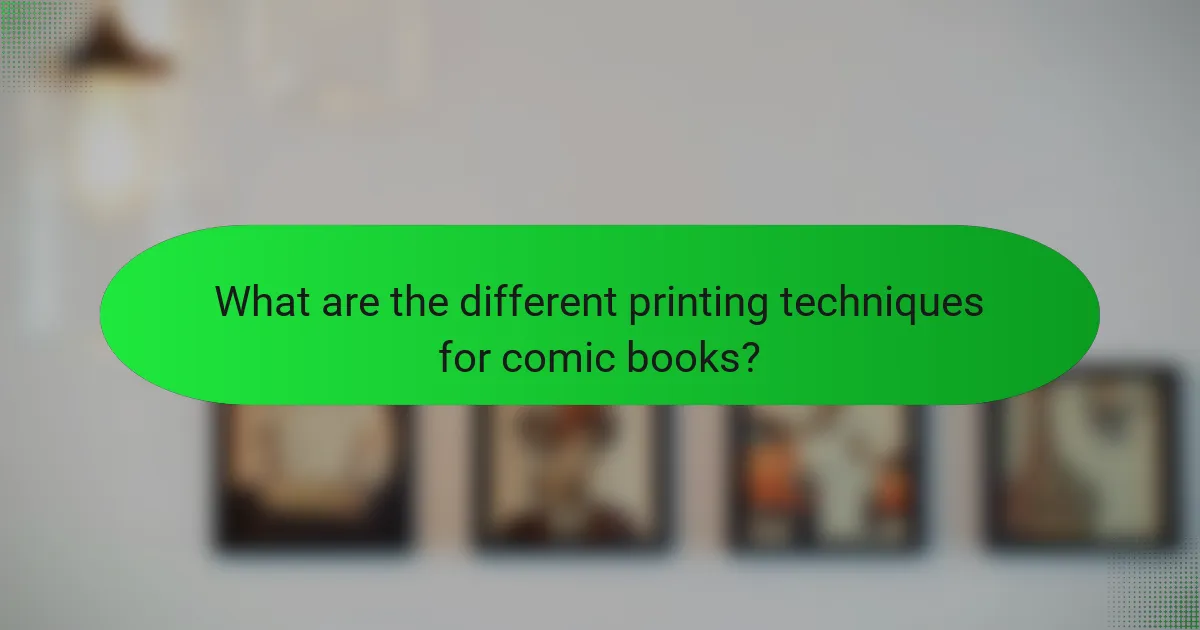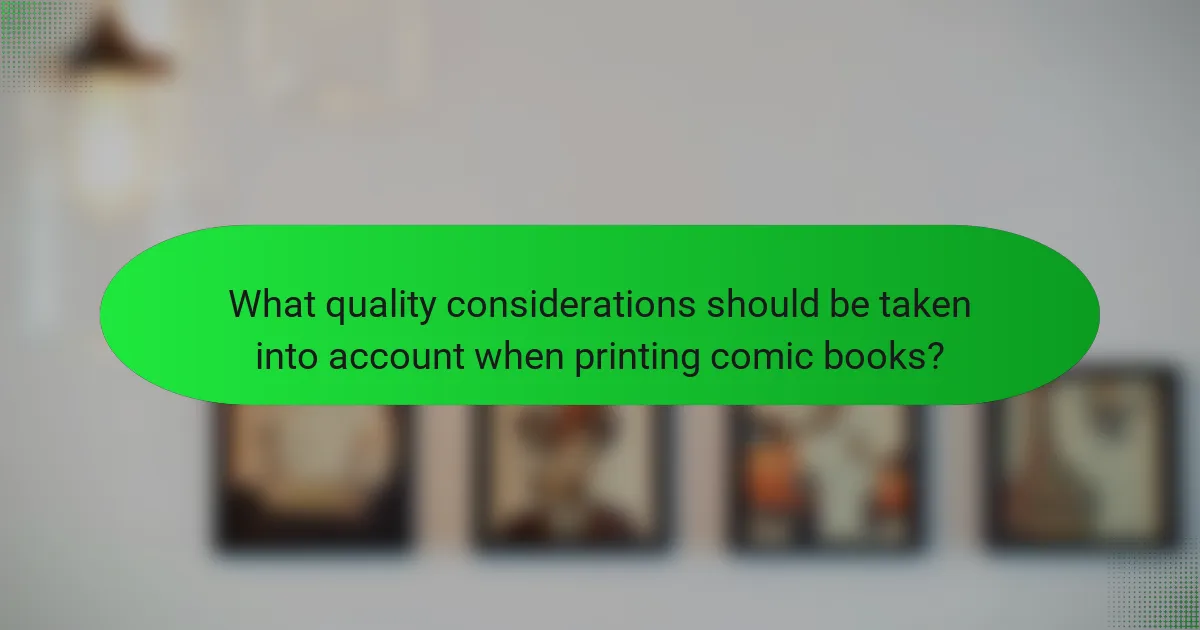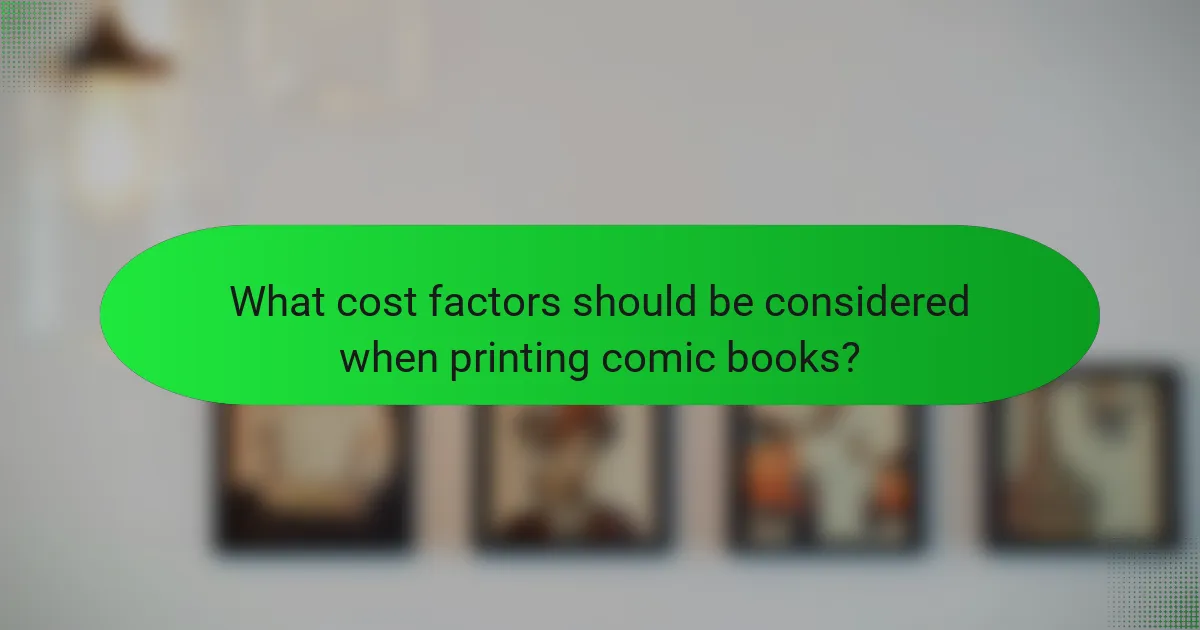The article focuses on printing techniques for comic books, detailing three primary methods: offset printing, digital printing, and risograph printing. Offset printing is favored for large runs due to its cost efficiency and quality, while digital printing offers quick turnarounds suitable for smaller projects. Risograph printing is noted for its vibrant colors and unique textures. Quality considerations include paper type, ink quality, and binding methods, all of which impact durability and visual appeal. Cost factors such as paper quality, printing method, and quantity are also examined, highlighting how these elements influence the overall expense of comic book production.

What are the different printing techniques for comic books?
The different printing techniques for comic books include offset printing, digital printing, and risograph printing. Offset printing is widely used for large runs due to its high-quality output and cost efficiency. It involves transferring ink from a plate to a rubber blanket and then onto the paper. Digital printing is ideal for smaller runs and offers quick turnaround times. It uses digital files directly to print, allowing for easy customization. Risograph printing combines features of screen printing and digital printing. It is known for its vibrant colors and unique textures. Each technique has its own strengths and is chosen based on the project’s specific needs.
How do traditional printing methods compare to digital printing for comic books?
Traditional printing methods and digital printing for comic books differ significantly in several aspects. Traditional printing, often using offset printing, requires a printing plate and is cost-effective for large runs. It provides high-quality color reproduction and consistent results across many copies. Digital printing, on the other hand, involves printing directly from digital files and is more flexible for smaller print runs. It allows for quicker turnaround times and customization options.
According to a study by the Printing Industries of America, traditional printing excels in quality for bulk orders, while digital printing is advantageous for short runs and personalized projects. The choice between the two methods often depends on the quantity needed and budget constraints.
What are the advantages of offset printing for comic books?
Offset printing offers several advantages for comic books. It provides high-quality images with sharp detail and vibrant colors. This printing method excels in color consistency across large print runs. It allows for cost-effective production when printing in bulk. The setup costs are offset by the lower per-unit price for larger quantities. Offset printing also supports a variety of paper types and weights, enhancing the comic’s tactile quality. Additionally, it enables precise registration, ensuring that artwork aligns perfectly. Overall, offset printing is ideal for comic books due to its efficiency, quality, and versatility.
What role does risograph printing play in comic book production?
Risograph printing plays a significant role in comic book production by providing a unique aesthetic and cost-effective printing solution. This technique allows for vibrant colors and textures that appeal to independent comic creators. Risograph machines use soy-based inks, which are environmentally friendly and offer a distinctive look. The printing process is efficient for small runs, making it ideal for self-publishers. Additionally, risograph printing supports a variety of paper types, enhancing the tactile experience of comic books. The affordability of this method enables artists to produce limited editions without high overhead costs. Overall, risograph printing contributes to the diversity and accessibility of comic book production.
What are the popular printing processes used in the comic book industry?
The popular printing processes used in the comic book industry include offset printing, digital printing, and risograph printing. Offset printing is widely used for its high-quality output and cost-effectiveness for large print runs. It utilizes plates that transfer ink to paper, ensuring vibrant colors and sharp images. Digital printing has gained traction for shorter runs and quick turnaround times. It allows for on-demand printing, reducing waste and storage needs. Risograph printing is known for its unique aesthetic and eco-friendly qualities. This process uses soy-based inks and can produce vibrant colors at lower costs for smaller batches. Each method offers distinct advantages based on print volume and desired quality.
How does screen printing differ from lithographic printing in comic book production?
Screen printing and lithographic printing differ significantly in comic book production. Screen printing involves pushing ink through a mesh screen to create images. This technique allows for vibrant colors and textures. It is often used for limited runs or special editions due to its manual nature. Lithographic printing, on the other hand, uses a flat printing plate. The process relies on the repulsion of oil and water to transfer images. This method is more efficient for large print runs. Lithography can produce finer details and smoother gradients. Overall, screen printing is ideal for unique designs, while lithography is suited for mass production.
What is the significance of flexography in comic book printing?
Flexography is significant in comic book printing due to its efficiency and versatility. This printing technique utilizes flexible relief plates, allowing for high-speed production. Flexography can print on various substrates, including paper and plastic. The process ensures vibrant colors and sharp images, enhancing comic book visuals. Additionally, it is cost-effective for large print runs. Flexography can handle intricate designs and fine details, which are crucial in comic art. Its quick drying time reduces production delays. Overall, flexography plays a pivotal role in meeting the demands of comic book publishers for quality and quantity.

What quality considerations should be taken into account when printing comic books?
Quality considerations when printing comic books include paper type, ink quality, and binding methods. The choice of paper affects durability and color reproduction. High-quality paper can enhance the visual appeal of illustrations. Ink quality influences color vibrancy and clarity. Using archival inks can prevent fading over time. Binding methods, such as perfect binding or saddle stitching, impact the comic’s longevity and usability. Each method has different durability and aesthetic effects. Additionally, print resolution must be high enough to maintain detail in artwork. A resolution of at least 300 DPI is recommended for sharp images. Finally, quality control during the printing process ensures consistency across copies. Regular checks can identify and correct issues before distribution.
How does paper quality affect the final product of comic books?
Paper quality significantly affects the final product of comic books. Higher quality paper enhances color reproduction and detail in artwork. It provides better durability, allowing comics to withstand wear and tear over time. Quality paper also influences the overall feel and weight of the comic, impacting reader experience. For instance, glossy paper can make colors appear more vibrant, while matte paper offers a more subdued finish. Additionally, paper weight affects the thickness of the comic, which can influence printing costs. According to industry standards, a weight of 80 lb to 100 lb is common for comic book interiors. In contrast, lower quality paper can lead to issues like ink bleed and fading, diminishing the visual appeal.
What types of paper are best suited for comic book printing?
The best types of paper for comic book printing are coated and uncoated papers. Coated paper offers a smooth finish, enhancing color vibrancy and detail. It is often used for the interior pages of comic books. Uncoated paper provides a more textured feel and is typically used for covers. Each type of paper has its advantages based on the desired aesthetic and durability. Coated papers generally have higher brightness and reflectivity. Uncoated papers can absorb ink better, resulting in a more muted color palette. The choice between these papers depends on the comic book’s artistic style and production budget.
How does the weight of the paper influence the overall quality of comic books?
The weight of the paper significantly influences the overall quality of comic books. Heavier paper typically provides better durability and a premium feel. It enhances the visual appeal of colors and graphics, making them appear more vibrant. Lighter paper may lead to a flimsy feel and can affect the longevity of the comic. The weight also impacts how well the pages hold up during handling and reading. For example, 80 lb paper is commonly used for high-quality comic books. This weight balances thickness with flexibility, ensuring a professional finish. In contrast, lighter papers can result in bleed-through issues with ink. Overall, the choice of paper weight is crucial for achieving desired quality standards in comic book production.
What role does color accuracy play in comic book printing quality?
Color accuracy is crucial for comic book printing quality. It ensures that the colors in the printed comic match the original artwork. Accurate colors enhance the visual appeal and maintain the artist’s intent. Inaccurate colors can lead to misinterpretation of the story and characters. Studies show that 80% of readers notice color discrepancies. This can affect their overall experience and satisfaction. High-quality printing processes focus on achieving precise color reproduction. Techniques like color calibration and proofing are essential for maintaining accuracy.
How can color profiles enhance the printing process for comic books?
Color profiles enhance the printing process for comic books by ensuring accurate color reproduction. They provide a standardized way to define colors across different devices. This standardization minimizes discrepancies between digital and printed colors. For example, the CMYK color model is commonly used in printing. It allows comic book artists to see how colors will appear on paper. Accurate color profiles can also help in achieving consistency across multiple print runs. This consistency is crucial for maintaining the visual integrity of comic book series. Research shows that using appropriate color profiles can reduce color correction time during the printing process. This efficiency leads to cost savings and improved turnaround times for comic book publishers.
What are the common issues with color reproduction in comic book printing?
Common issues with color reproduction in comic book printing include color shifting, registration problems, and ink saturation. Color shifting occurs when printed colors differ from those on digital screens. This can happen due to differences in color profiles. Registration problems arise when colors do not align correctly during the printing process. This misalignment can lead to blurred or overlapping colors. Ink saturation issues occur when too much ink is applied, causing colors to appear darker or muddied. Each of these issues can significantly affect the visual quality of comic book prints.

What cost factors should be considered when printing comic books?
Cost factors to consider when printing comic books include paper quality, printing method, and quantity. Paper quality affects both durability and cost. Higher quality paper typically increases the overall price. The printing method, such as digital or offset printing, also influences costs. Digital printing is often more cost-effective for smaller runs. Conversely, offset printing may be cheaper for larger quantities. Additionally, the number of copies impacts the per-unit cost. Larger print runs usually lower the cost per comic. Other factors include color choices, binding types, and additional features like gloss or matte finishes. Each of these elements contributes to the final price of comic book printing.
How do printing techniques impact the overall cost of comic book production?
Printing techniques significantly impact the overall cost of comic book production. Different printing methods, such as digital and offset printing, have varying costs associated with setup and materials. Digital printing generally incurs lower initial costs, making it suitable for small runs. Offset printing, while cost-effective for larger quantities, requires higher upfront expenses for plates and setup. The choice of paper quality also affects costs; higher-quality paper increases production expenses. Furthermore, color printing is more expensive than black and white due to ink usage. Ultimately, the selected printing technique and its associated attributes directly influence the total production cost of comic books.
What are the cost differences between digital and traditional printing methods?
Digital printing is generally more cost-effective for short runs, while traditional printing is more economical for large volumes. Digital printing eliminates setup costs, making it ideal for small quantities. Traditional printing involves higher initial costs due to plate creation and setup. However, per-unit costs decrease significantly with larger orders in traditional printing. For example, a digital print run of 100 copies may cost $2 per copy, while a traditional print run of 1000 copies could reduce the cost to $0.50 per copy. This cost structure is influenced by factors such as material costs, labor, and production time.
How does the quantity of prints affect the cost per unit in comic book printing?
The quantity of prints directly affects the cost per unit in comic book printing. Generally, higher quantities lead to lower costs per unit. This is due to economies of scale in the printing process. When more copies are printed, fixed costs are spread over a larger number of units. For instance, setup costs remain constant regardless of print volume. Therefore, the more prints produced, the lower the average cost per comic book. Industry data indicates that printing 500 copies can cost $2 per unit, while printing 5,000 copies may reduce that cost to $0.50 per unit. Thus, quantity plays a crucial role in determining unit economics in comic book printing.
What additional costs should be factored into comic book printing projects?
Additional costs for comic book printing projects include design fees, shipping costs, and proofing expenses. Design fees cover artwork, layout, and formatting. Shipping costs arise from transporting printed copies to retailers or customers. Proofing expenses involve creating sample copies for quality checks before full production. Other potential costs are storage fees for unsold inventory and marketing expenses for promotion. According to industry standards, these factors can significantly affect the overall budget.
How do design and pre-press costs influence the total printing budget?
Design and pre-press costs significantly influence the total printing budget. These costs encompass artwork creation, layout design, and preparation for printing. High-quality design may require professional services, which can increase initial expenses. Pre-press processes include color correction, proofing, and file formatting. Each step in pre-press ensures that the final product meets quality standards. If errors occur during design or pre-press, they can lead to additional costs for corrections and reprints. According to industry standards, pre-press costs can account for 20-30% of the overall printing budget. Thus, careful budgeting for design and pre-press is essential for managing total printing costs effectively.
What are the implications of shipping and distribution costs for printed comic books?
Shipping and distribution costs significantly impact the pricing and availability of printed comic books. These costs can affect profit margins for publishers and retailers. High shipping fees can lead to increased retail prices, making comics less accessible to consumers. Additionally, shipping delays can disrupt release schedules, affecting sales and reader engagement. The geographical distance between publishers and retailers also influences these costs. For example, shipping internationally can double or triple expenses. Efficient logistics and distribution strategies are essential to mitigate these costs. Publishers may choose local printing options to reduce shipping expenses. Ultimately, shipping and distribution costs play a crucial role in the overall economics of the comic book industry.
What are the best practices to optimize printing costs for comic books?
To optimize printing costs for comic books, consider bulk printing. Bulk printing reduces the cost per unit significantly. Choose the right paper stock to balance quality and cost. Thinner paper can lower expenses without compromising too much on quality. Utilize digital printing for smaller runs, as it can be more cost-effective than traditional methods.
Design with print specifications in mind to minimize waste. Use fewer colors in the design to reduce ink costs. Print on standard sizes to avoid additional cutting fees. Collaborate with a printer who understands comic book specifications for better pricing options. Research various printers to compare quotes and services.
The main entity of the article is the printing techniques used for comic books. The article provides a comprehensive overview of various printing methods, including offset, digital, and risograph printing, highlighting their unique attributes, advantages, and suitability for different print runs. It also discusses quality considerations such as paper type, ink quality, and binding methods, as well as cost factors that impact comic book production. Additionally, the article examines the implications of design, shipping, and distribution costs, offering best practices for optimizing printing expenses.